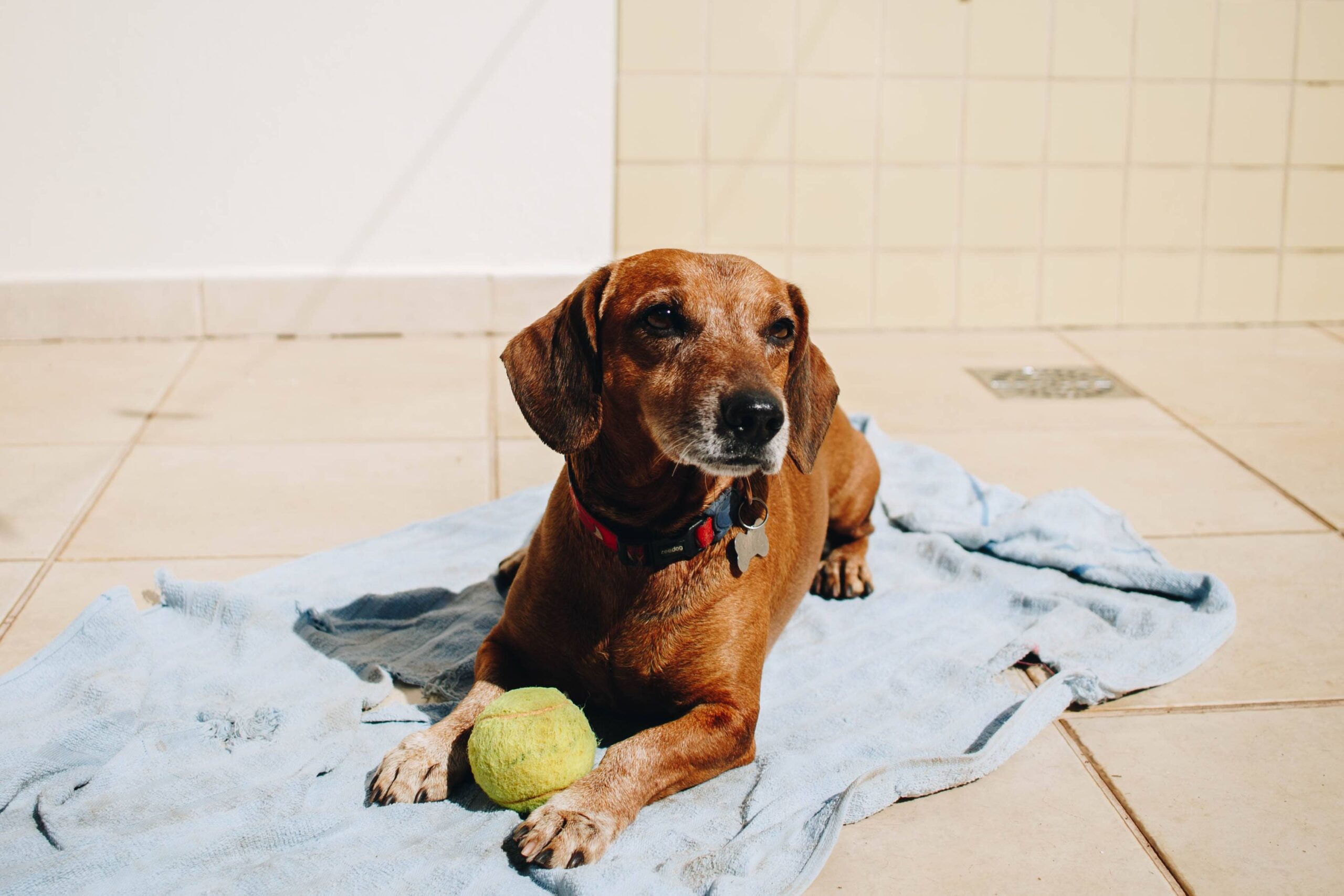One of the biggest joys that comes with having a dog is being able to take them out and about with you, wherever you want to go! Whether it’s a day out at the park or beach, or an outing to a dog-friendly coffee shop or restaurant, having a dog who’s well-behaved and happy enough to experience everything life has to offer with you is really rewarding. However, it takes time, patience, and effort from both you and your dog to achieve this in your day to day lives. There are plenty of skills that you and your dog can learn together to help make your time out and about as stress-free as possible. One such skill is the ability to teach your dog to settle down in almost any situation. This is useful for when you want your dog to lay calmly by your side, for example, while you enjoy a meal or a drink in what could be a fairly busy environment!
In today’s blog post, we’ll be using a case study of Jess and her owner Alun. Alun wanted to learn some exercises to train Jess to lay settled by his side in a coffee shop or beer garden. Over their virtual online training session, we outlined the steps below to help Jess and Alun master this skill. So, if you want to teach your dog to settle down when you’re out and about, these tips should help!
For these training exercises, you will need a lead, harness or collar, high-value treats, and a training mat.
Exercise 1: The Release Cue
In short, a ‘release cue’ is a signal that you give your dog to tell them that something is finished and that it’s okay to move on. It’s an important exercise for all sorts of training, not just teaching your dog to settle. This is because it allows you to transition between different elements during training, or your general time together. In this instance, with Jess and Alun, we used the release cue because we wanted to repeat the same exercise a number of times to help Jess pick it up more easily. Here are the steps to follow if you want to train this skill:
Step One: Take a hold of your dog’s collar and throw a treat just in front of you. Pause. Then, give your release cue, such as ‘OK’, and release their collar at the same time. Repeat this exercise five times, throwing the treat in roughly the same place each time. The aim of this step is to start teaching your dog that once they hear the release cue, it’s time to proceed to whatever comes next. As you progress, you can practice by throwing the treat in different places in the same room. And, you can increase the difficulty even further by changing rooms, or going outside.
Step Two: Place your training mat on the floor in the same room and put a sprinkle of treats in the centre of the mat. Once your dog has finished eating the treats, give your release cue and throw a treat off the mat. At first, keep it close to the mat and don’t throw it around the room, as this is too difficult at an early stage. Repeat this exercise five times. Then, roll up the mat before moving on to the next exercise.
When you’re ready to increase the difficulty, you can start to throw the treat in various places around the room, and progress further to other rooms and outside. Whenever you go to a new location, you should go back to the original step of throwing the treat in one place. It’s a good idea to make things easy for your dog whenever you move locations. This is because new locations can mean different things to different dogs, and it’s important to be mindful of this when training.
Exercise Two: Reward Marker
Next up, you can help teach your dog to settle down by using a reward marker. This is a word or sound that communicates to your dog that the behaviours completed at that time is the desired behaviour that you want from them. Teaching your dog a reward marker is another skill that is very useful for all sorts of training situations. In this instance, you will use it to mark the desired behaviour as placing two or more feet on the training mat. We train this by using a word that is clean, clear, and not used in everyday speech, and associating that sound with food. In our session with Jess and Alun, we used the word ‘Yep’. The plan is that Jess will always predict food when she hears the reward marker ‘Yep’. Here are the steps to follow to teach something similar to your dog:
Step One is teaching the actual reward marker before you start using it in training. This is so your dog learns to predict food soon after hearing the word. To do this in a clear sequence, clearly say your chosen reward marker word such as ‘Yep,’ wait one second, and place a food reward in your dog’s mouth. Repeat the process in quick succession for ten repetitions. Then, repeat another set.
Step Two is building up positive associations with the training mat, so that we can introduce it in training and help the dog understand that good things happen when they engage with the mat! To do this, place the mat on the floor in the same room you worked in previously. Sprinkle some high value treats in the middle of the mat. After your dog has finished the treats, use the release cue ‘OK,’ and throw a treat away from the mat as we did earlier. Repeat the exercise five times. As mentioned, the release cue is used so that we can transition and repeat this exercise several times. In her training session, Jess was very good at this exercise so it’s clear that she had positive experiences with the training mat in her previous home. This goes to show how training good behaviours such as these from an early age can benefit a dog throughout its whole life!
Step Three is the introduction of the reward marker combined with the training mat. In previous steps, the aim has been to lure the dog onto the training mat using food. This next step increases the difficulty and progress so that the food reward isn’t needed for the dog to transition to the mat. In this way, the dog should learn that the desired behaviour is something to do with the mat. This time, use the sequence set out in step two, but include the reward marker ‘Yep’ when two or more feet are on the mat. In our training session, Jess had been offering this behaviour anyway, we are just adding something else to the sequence. With practice, because Jess had developed a good association with the mat, we could remove the food used as a lure to the mat at an early stage, which was great! But, different dogs will need different amounts of training time to master this skill. So, if it doesn’t happen as quickly for you, keep going and training the skill consistently to get the desired results.
Here, as with the previous steps, you can increase the difficulty by changing the position of where you send your dog off the mat, by throwing food to different areas of the room. Once this has been mastered, you can increase the difficulty even further by using other locations.
As an owner, it’s always a judgement call about when to move along to another step, or to increase the difficulty of a step. If at any time you feel that your dog doesn’t understand, then it’s best to go back to a previous location or step for a while.
How does this teach your dog to settle down when you’re out and about?
The training exercises mentioned above are great for helping your dog to learn how to settle in the outside world, such as a coffee shop or restaurant. It does this by encouraging your dog to have a positive association with their training mat. You can then take the training mat out and about with you, and use it to encourage your dog to settle down next to you when you’re otherwise engaged in your meal, drink, or more!
Another tip if you’re struggling to get your dog to settle when out and about is to take them on a walk before you reach the destination where they’ll need to be settled. This gives them a chance to get some exercise in and relieve themselves beforehand, so they should be calmer and more willing to settle.
It was a pleasure to work with Jess and Alun on this virtual training session. We were all really pleased with the progress that Jess made, and the skills that she and Alun can now build upon so that they can go out and about together with ease! Here at Royvon, we would love to work with you and your dog, either via a virtual training session or at one of our locations. We work with dogs and their owners who are encountering all sorts of issues, from specific skills that you’d like to learn, such as how to teach your dog to settle, to helping combat more severe behavioural problems. Please visit our website to find out more, or get in touch today to discuss how we can help you!




Leave A Comment